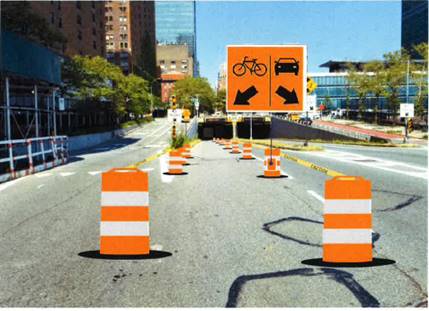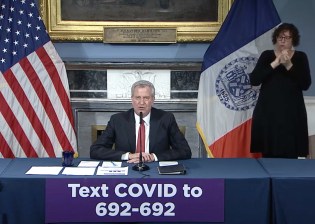Mayor Announces Emergency Bike Lanes for Smith Street, Second Ave. ‘Gap’

It’s a start.
Mayor de Blasio today announced that he would add temporary protected bike lanes to two very busy bike corridors — Smith Street in Brooklyn and Second Avenue near the Queens Midtown Tunnel in Manhattan — a long-overdue effort to increase bike safety at a time when cycling and cycling injuries are on the rise.
He promised that there would be more such emergency measures after the first two lanes are installed “by the end of next week.”
“We intend to look very quickly and aggressively at how we can do more,” the mayor said during his daily teleconference (the new normal in the age of coronavirus). “We’ll announce them as soon as we’re ready. … We want to see an expansion quickly.”
The mayor’s announcement of just two lanes will likely disappoint bike advocates, such as Transportation Alternatives, which called for far greater steps two weeks ago after the mayor himself had asked New Yorkers to bike to work if they could.
That request did indeed set off a surge of cycling, with higher ridership on Citi Bike and by commuters, city stats show. Those numbers have started to decrease now that so many people are out of work, but cycling is still proving to be a key mode of transportation for people who still have jobs and, obviously, New York’s delivery workers.
The new protection along key routes couldn’t come soon enough. As Streetsblog reported yesterday, cycling injuries were up 43 percent last week, according to the NYPD.
TransAlt Executive Director Danny Harris issued a brief statement thanking the mayor.
“[It’s] a good start and we look forward to advancing these and more protected lanes together to keep NYC moving during COVID-19,” he tweeted.
Others, including Council Speaker Corey Johnson, have requested that New York follow the lead of cities such as Portland, which has closed some residential streets to automobile traffic so residents can socialize but at a distance, but the mayor deflected. He did say the city hopes to create more open space — such as in school yards or with a “Summer Streets” approach — but he was ultimately vague when Streetsblog asked specifically about shutting some residential streets.
Council Speaker Corey Johnson on Friday urged the city to close certain streets to traffic to give more room to pedestrians and urged the state to declare bike shops “essential” businesses that can operate during the coronavirus lockdown. https://t.co/qCcVIItaNB
— Corey Johnson (@CoreyinNYC) March 20, 2020
“Without overstating it and to put some brakes on you and make sure that your interpretation doesn’t get too energetic,” he started, “we are definitely interested in creating more space outdoors so people can do social distancing. … The question is how do we create more space. That is not the same as closing residential streets.”
That won’t satisfy Council Member Costa Constantinides, who shared Johnson’s request and also urged the DOT to build some new infrastructure in Queens.
“Western Queens could use a north-to-south temporary protected route — particularly one that links northern Astoria to the Queensboro Bridge — as well as an east-to-west option that gets riders to the cross-river span,” he wrote in a letter to the agency. “This would incentivize those who must head to a government building in Long Island City or Manhattan to cycle if they are able. It would reduce the need for them to travel along the N/W line, where air circulation is not as strong.
“Likewise, I echo Speaker Corey Johnson’s call to make certain streets available only to pedestrians in a bid to promote social distancing,” he said.
This is a breaking story. Please check back later.
